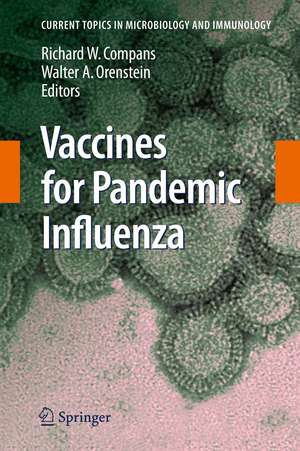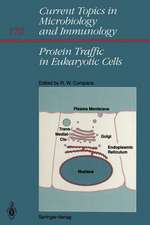Vaccines for Pandemic Influenza: Current Topics in Microbiology and Immunology, cartea 333
Editat de Richard W Compans, Walter A. Orensteinen Limba Engleză Paperback – 29 noi 2011
| Toate formatele și edițiile | Preț | Express |
|---|---|---|
| Paperback (1) | 1826.85 lei 6-8 săpt. | |
| Springer Berlin, Heidelberg – 29 noi 2011 | 1826.85 lei 6-8 săpt. | |
| Hardback (1) | 1832.08 lei 6-8 săpt. | |
| Springer Berlin, Heidelberg – 28 iul 2009 | 1832.08 lei 6-8 săpt. |
Din seria Current Topics in Microbiology and Immunology
- 18%
 Preț: 962.03 lei
Preț: 962.03 lei - 5%
 Preț: 1123.13 lei
Preț: 1123.13 lei - 5%
 Preț: 1085.95 lei
Preț: 1085.95 lei -
 Preț: 499.77 lei
Preț: 499.77 lei - 5%
 Preț: 967.81 lei
Preț: 967.81 lei - 18%
 Preț: 1118.62 lei
Preț: 1118.62 lei - 5%
 Preț: 717.00 lei
Preț: 717.00 lei - 5%
 Preț: 712.97 lei
Preț: 712.97 lei - 5%
 Preț: 709.51 lei
Preț: 709.51 lei - 5%
 Preț: 709.51 lei
Preț: 709.51 lei - 5%
 Preț: 721.19 lei
Preț: 721.19 lei - 5%
 Preț: 359.78 lei
Preț: 359.78 lei - 5%
 Preț: 711.88 lei
Preț: 711.88 lei - 5%
 Preț: 774.81 lei
Preț: 774.81 lei - 15%
 Preț: 640.06 lei
Preț: 640.06 lei - 5%
 Preț: 717.00 lei
Preț: 717.00 lei - 5%
 Preț: 360.34 lei
Preț: 360.34 lei - 5%
 Preț: 707.69 lei
Preț: 707.69 lei - 5%
 Preț: 717.56 lei
Preț: 717.56 lei - 5%
 Preț: 716.28 lei
Preț: 716.28 lei - 5%
 Preț: 717.20 lei
Preț: 717.20 lei - 5%
 Preț: 711.32 lei
Preț: 711.32 lei - 5%
 Preț: 711.88 lei
Preț: 711.88 lei - 5%
 Preț: 718.29 lei
Preț: 718.29 lei - 5%
 Preț: 709.51 lei
Preț: 709.51 lei - 5%
 Preț: 369.84 lei
Preț: 369.84 lei - 5%
 Preț: 712.25 lei
Preț: 712.25 lei - 5%
 Preț: 716.45 lei
Preț: 716.45 lei - 5%
 Preț: 706.60 lei
Preț: 706.60 lei - 5%
 Preț: 711.52 lei
Preț: 711.52 lei - 5%
 Preț: 713.54 lei
Preț: 713.54 lei - 5%
 Preț: 720.47 lei
Preț: 720.47 lei - 5%
 Preț: 725.42 lei
Preț: 725.42 lei - 5%
 Preț: 708.06 lei
Preț: 708.06 lei - 5%
 Preț: 713.70 lei
Preț: 713.70 lei - 5%
 Preț: 705.83 lei
Preț: 705.83 lei - 5%
 Preț: 710.96 lei
Preț: 710.96 lei - 5%
 Preț: 723.93 lei
Preț: 723.93 lei - 5%
 Preț: 707.69 lei
Preț: 707.69 lei - 5%
 Preț: 715.35 lei
Preț: 715.35 lei - 5%
 Preț: 709.87 lei
Preț: 709.87 lei - 5%
 Preț: 359.05 lei
Preț: 359.05 lei - 5%
 Preț: 374.20 lei
Preț: 374.20 lei - 15%
 Preț: 635.31 lei
Preț: 635.31 lei - 5%
 Preț: 707.86 lei
Preț: 707.86 lei - 5%
 Preț: 721.96 lei
Preț: 721.96 lei - 15%
 Preț: 632.88 lei
Preț: 632.88 lei - 15%
 Preț: 632.05 lei
Preț: 632.05 lei - 15%
 Preț: 642.83 lei
Preț: 642.83 lei
Preț: 1826.85 lei
Preț vechi: 2227.87 lei
-18% Nou
Puncte Express: 2740
Preț estimativ în valută:
349.58€ • 373.81$ • 291.46£
349.58€ • 373.81$ • 291.46£
Carte tipărită la comandă
Livrare economică 17 aprilie-01 mai
Preluare comenzi: 021 569.72.76
Specificații
ISBN-13: 9783642242403
ISBN-10: 3642242405
Pagini: 532
Ilustrații: XVIII, 512 p. 51 illus., 30 illus. in color.
Dimensiuni: 155 x 235 x 28 mm
Greutate: 0.74 kg
Ediția:2009
Editura: Springer Berlin, Heidelberg
Colecția Springer
Seria Current Topics in Microbiology and Immunology
Locul publicării:Berlin, Heidelberg, Germany
ISBN-10: 3642242405
Pagini: 532
Ilustrații: XVIII, 512 p. 51 illus., 30 illus. in color.
Dimensiuni: 155 x 235 x 28 mm
Greutate: 0.74 kg
Ediția:2009
Editura: Springer Berlin, Heidelberg
Colecția Springer
Seria Current Topics in Microbiology and Immunology
Locul publicării:Berlin, Heidelberg, Germany
Public țintă
Professional/practitionerCuprins
Pandemic Influenza Overview.- Pandemic Influenza as a Current Threat.- Antigenic Cross-Reactivity Among H5N1 Viruses.- Current Approaches for Human and Avian Vaccine Production.- Seasonal Influenza Vaccines.- Generation and Characterization of Candidate Vaccine Viruses for Prepandemic Influenza Vaccines.- Live Attenuated Vaccines for Pandemic Influenza.- Influenza Vaccines for Avian Species.- Development and Application of Avian Influenza Vaccines in China.- Novel Vaccine Approaches.- Designing Vaccines for Pandemic Influenza.- Attenuated Influenza Virus Vaccines with Modified NS1 Proteins.- DNA Vaccines Against Influenza Viruses.- Recombinant Proteins Produced in Insect Cells.- Influenza Neuraminidase as a Vaccine Antigen.- Recombinant Vectors as Influenza Vaccines.- Influenza Virus-Like Particles as Pandemic Vaccines.- Pandemic Influenza Vaccines.- Adjuvants for Pandemic Influenza Vaccines.- Novel Approaches for Vaccine Delivery.- Transcutaneous Immunization with Influenza Vaccines.- Microneedle-Based Vaccines.- Vaccine Evaluation, Production and Distribution.- Animal Models for Evaluation of Influenza Vaccines.- Immunosenescence and Influenza Vaccine Efficacy.- Vaccines for Pandemic Influenza: Summary of Recent Clinical Trials.- Considerations for Licensure of Influenza Vaccines with Pandemic and Prepandemic Indications.- Strategies for Broad Global Access to Pandemic Influenza Vaccines.- Prioritization of Pandemic Influenza Vaccine: Rationale and Strategy for Decision Making.
Textul de pe ultima copertă
Recent years have seen unprecedented outbreaks of avian influenza A viruses. In particular, highly pathogenic H5N1 viruses have not only resulted in widespread outbreaks in domestic poultry, but have been transmitted to humans resulting in numerous fatalities. The rapid expansion in their geographic distribution and the possibility that these viruses could acquire the ability to spread from person to person raise the risk that such a virus could cause a global pandemic with high morbidity and mortality. An effective influenza vaccine represents the best approach to prevent and control such an emerging pandemic. However, current influenza vaccines are directed at existing seasonal influenza viruses, which have limited antigenic relationships to the highly pathogenic H5N1 strains. Concerns about pandemic preparedness have greatly stimulated research activities to develop effective vaccines for pandemic influenza viruses, and to overcome the limitations inherent in current approaches to vaccine production and distribution. These limitations include the use of embryonated chicken eggs as the substrate for vaccine production; which is time-consuming and could involve potential biohazards in growth of new virus strains. Other limitations include the requirement that the current inactivated influenza vaccines be administered using needles and syringes, requiring trained personnel, which could be a bottleneck when attempting to vaccinate large populations in mass campaigns. In addition, the current inactivated vaccines which are delivered by injection elicit limited protective immunity in the upper respiratory tract where the infection process is initiated. Most of these limitations of the current vaccines are being addressed by research on novel approaches to vaccine development and delivery that are described in many of the chapters in this volume.


















